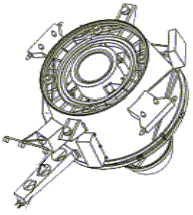Ion Drives

One of the best ways to travel around the solar system has never been used in practice, except for brief tests. It is called an ion drive. The idea is to use electricity to accelerate electrically charged particles -- ions -- instead of using chemical reactions. In a chemical rocket, the fuel is burned rapidly, and is gone in a few minutes. In an ion drive, the fuel is produced one atom at a time, and can be fired for months on end. Though the thrust is much smaller than in a chemical rocket, if the spacecraft is already in orbit, a tiny thrust fired for a long time will accelerate it to a very high speed (about 30 km/second). When xenon ions are emitted at such high speed as exhaust from a spacecraft, they push the spacecraft in the opposite direction.
The fuel for an ion drive would be a metal such as cesium. Cesium is easily vaporized, and can be accelerated by electrical fields. Solar panels would convert sunlight into electricity, which would then be used to power the ion drive.
NASA designed an ion drive to take a spacecraft to Halley's Comet. Unfortunately, Congress did not provide the money for the project, so it has never flown. But the idea is excellent. The first use of ion drive as the primary means of interorbital propulsion was launched in July 1998, in a low budget NASA asteroid and comet flyby mission, the Deep Space 1 (DS1) mission. The spacecraft encountered asteroid 3352 in January 1999, it will fly by Mars, then visit comet West-Kohoutek-Ikemura in June 2000. It will do all that on a low fuel budget using ion drive.
Experiments on ion drives have been conducted in laboratories in several countries, but the first space test was done by the Soviet Union in 1984 by a Vostok spacecraft. Because ion drives have such small thrusts, you cannot use them to get from the surface of the Earth into space. But if you use a conventional rocket to get into orbit, you can then launch an ion drive craft to the Moon, Mars, or anywhere else in the solar system.

More Details on the ION Drive
Ion drive thrusters use an electric field to accelerate charged atoms or molecules (e.g., oxygen) to a high velocity as they are expelled out the thrust chamber, thus accelerating the spacecraft.
Ion thrusters generally use a cathode (a negatively charged grid similar to that found in a tv set) to generate a stream of electrons, which form an electric circuit with a positively charged ring - the anode. This stream of electrons is used to ionise the propellant. A small magnetic field is used to aid this process (electrons spiral around the magnetic field lines, increasing the chance of electron-atom collisions), which may derive from either a permanent magnet or an electromagnet.
The ionised gas drifts towards an extraction grid system (two or three plates with many small holes in them, held at high voltage) where they are accelerated out of the thruster, so producing thrust. A neutraliser similar to the cathode is used to generate free electrons and balance the overall space charge in the outgoing beam so that the spacecraft doesn't charge itself up.
The electric power comes from a solar cell array. Of course, in orbital space, there is no air drag or weather forces, so the solar cell array doesn't need to be aerodynamic at all. Since the ion drive vehicle is relatively low thrust, the structural strength and mass can be low as well. For example, in the General Dynamics report: "The solar array performance was conservatively assumed for sizing purposes to be 150 watts/kilogram" (27) based on a very conservative assumption of solar cells having only 7% efficiency. The assumed efficiency of ion drive at converting electrical energy into beam kinetic energy was 63%, though some ion thrusters today produce efficiencies between 70% and 90%.
Ion thrusters are modular. If you have more cargo or want to speed up your mission or slow it down to conserve fuel, then you can add or subtract thrusters and solar cell array units.
Ion drive engines have long lives, being subject to a much less stressful environment than chemical rocketry. Ion drive engines are also easier to work on, consisting of simple electrical components, in contrast to the high performance mechanical pumps of chemical rocketry.
Ion drive was developed in laboratories in the 1960's, and there were the SERT1 and SERT2 experiments in space which proved that the drive would work in space for long periods of time and deliver significant propulsion to a spacecraft. When the space program shrunk due to poor political leadership after the Kennedy-Johnson era, ion drive was one area that saw research and development wane. However, some private communications satellites in geosynchronous orbit incorporated ion drive into their stationkeeping system once the satellite was delivered there by a chemical rocket and its solar cell array deployed to power the ion drive engine.
The NASA Lewis Research Center is developing a lower power version (about 700 Watts) of the DS1 NSTAR ion drive engine system. However, large scale space industrialization will use larger ion drive engines, or else many low power units together in a modular craft, the latter offering spacecraft security in case an engine or two fail.
In any case, ion drive is looking as if it will become a routine means of interorbital propulsion within the next 5 years for low cost scientific missions as well as industrial missions.
Comments, criticisms, suggestions, and additions welcome! E-mail me at [email protected]. Babylon 5, characters, names, and all related indicia are trademarks of Time Warner Entertainment Co., LP. ©1994-1998 Time Warner Entertainment Co. All original text, artwork and page design ©1998 Fournel Computer Services Inc.